Wiggling through a phalanx of mid-rise housing blocks, a covered walkway and attached café serve as a colorful antidote to the regimented architecture all around it. Designed by the Madrid-based firm SelgasCano, the irrepressible explosion of angled-steel tubing and corrugated-metal roofing is a social magnet for the thousands of residents in Bailuwan Town. As has happened throughout China during the past three decades, the area two hours’ driving distance from the coastal city of Qingdao has been rapidly transformed from farmland. The developer makes its profit from the housing components—which are heavily formatted in siting, plan, and scale and usually designed by large Chinese firms—but entices buyers with a series of eye-catching, break-the-mold structures often designed by foreign architects. At Bailuwan, in addition to Junya Ishigami, the developer commissioned Sou Fujimoto, Ryue Nishizawa, and SelgasCano to create these special elements, each firm working independently of the others to add a different spice to the architectural stew. Some of these have been built, while others—including a hotel and a residential complex by SelgasCano—remain on hold as China’s once-booming housing sector now faces a monumental bust.
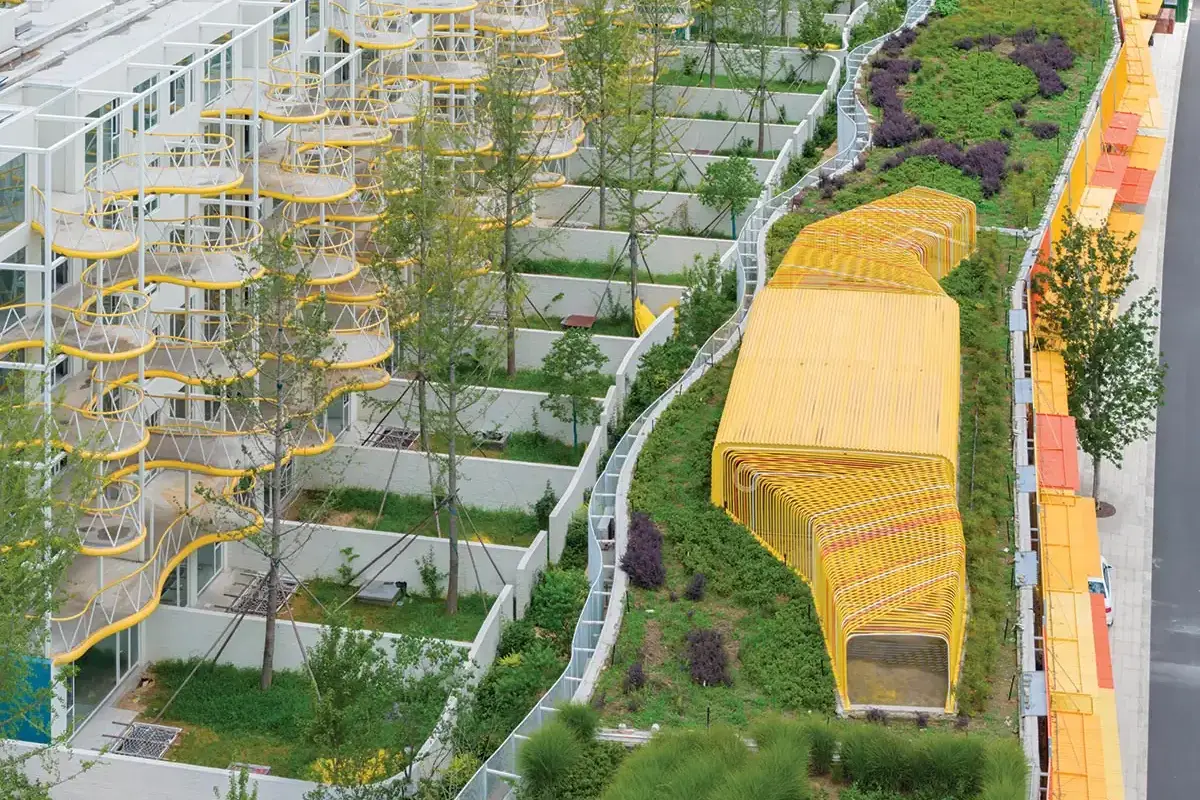
1
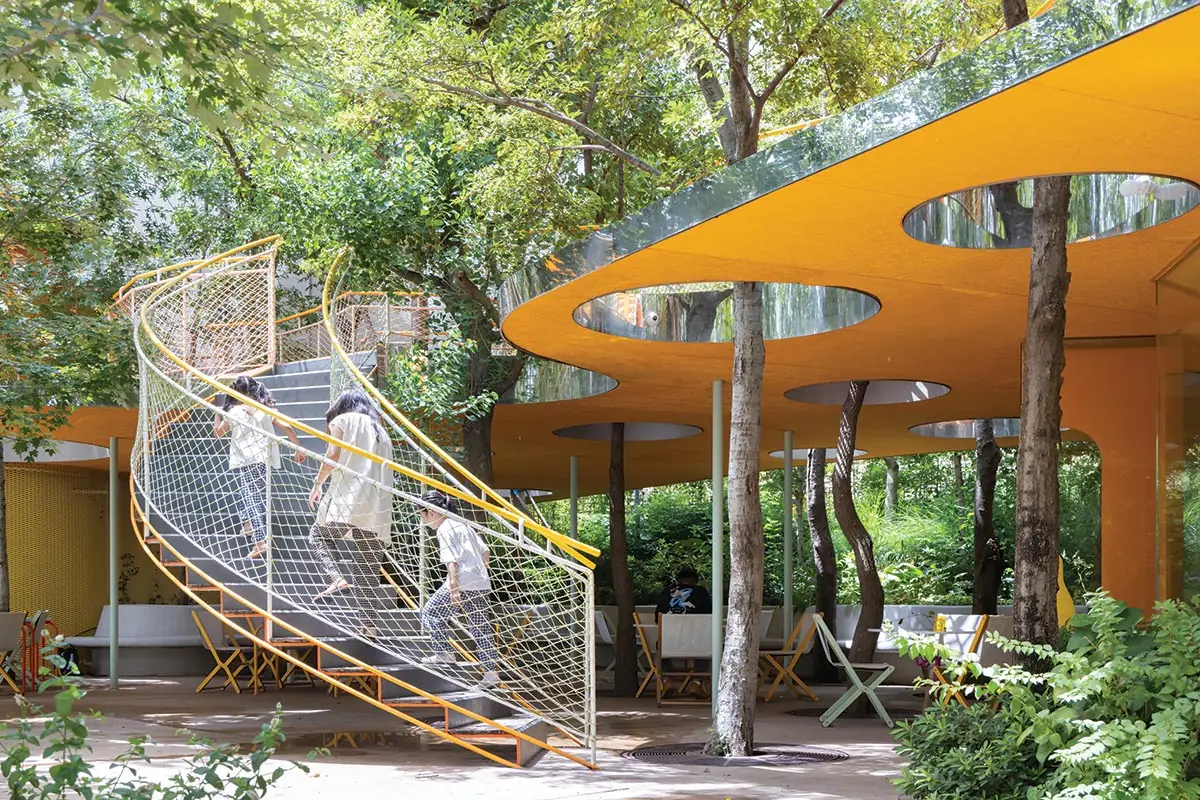
2
The architects enlivened the town with color and trees—along a walkway (top of page), on balconies (1), and at a café (2). Photos © Iwan Baan, click to enlarge.
José Selgas and his partner Lucía Cano had never worked in China. But Xu Qunde, the chairman of the Shandong Bailuwan Company, approached them and traveled to Madrid shortly before the Covid pandemic began. “He turned out to be one of our best clients,” says Selgas, who found the chairman thoroughly engaged in the project and willing to solve any problem that arose during construction. Although the apartment buildings on-site had already been designed, Xu allowed SelgasCano to add curving, yellow-accented balconies on one side and devise a color scheme and new composition for fenestration on the other. The project goal was to enliven the housing blocks and create visual connections, which was also achieved with the promenade and café that would snake through the center of the site. The contrast to the red-brick, residential monoliths could not be starker.
Selgas and Cano at first considered relating their designs to Chinese antecedents. Xu rejected that approach, the only time he dismissed an idea outright. He agreed, however, on integrating architecture and landscape, blurring indoors and out. While this strategy has deep roots in Chinese pavilion and garden design, the Bailuwan walkway and café would make no direct historical allusions. Instead, they’re a contemporary assemblage of elements SelgasCano has used before—steel tubing, corrugated metal, and acrylic panels—responding to the particulars of site, program, climate, and culture.
“We always try to do less,” says Selgas. “Use less material, consume less energy, make it lighter.” So the firm’s 575-foot-long covered passage dances gracefully above the ground, open on all sides and allowing air and daylight to trickle through gaps in the irregularly shaped roof pieces. Known for their vibrant use of color, Selgas and Cano eventually selected a progression of tones ranging from willow green and olive to beige and tan. The architects insisted on using high-quality paint so it would last for many years.
Paired angled-steel tubes serve as columns and hold up the same kind of tubes used as beams to support corrugated-steel roof panels. Those tubes become benches when laid horizontally and connected to the columns; SelgasCano originally proposed using a custom connector for attaching tubes, but the client ended up welding the pieces. Pavers are handmade ceramic tiles, which came from Spain after the architects—surprisingly—couldn’t find any appropriate fabricators in China.
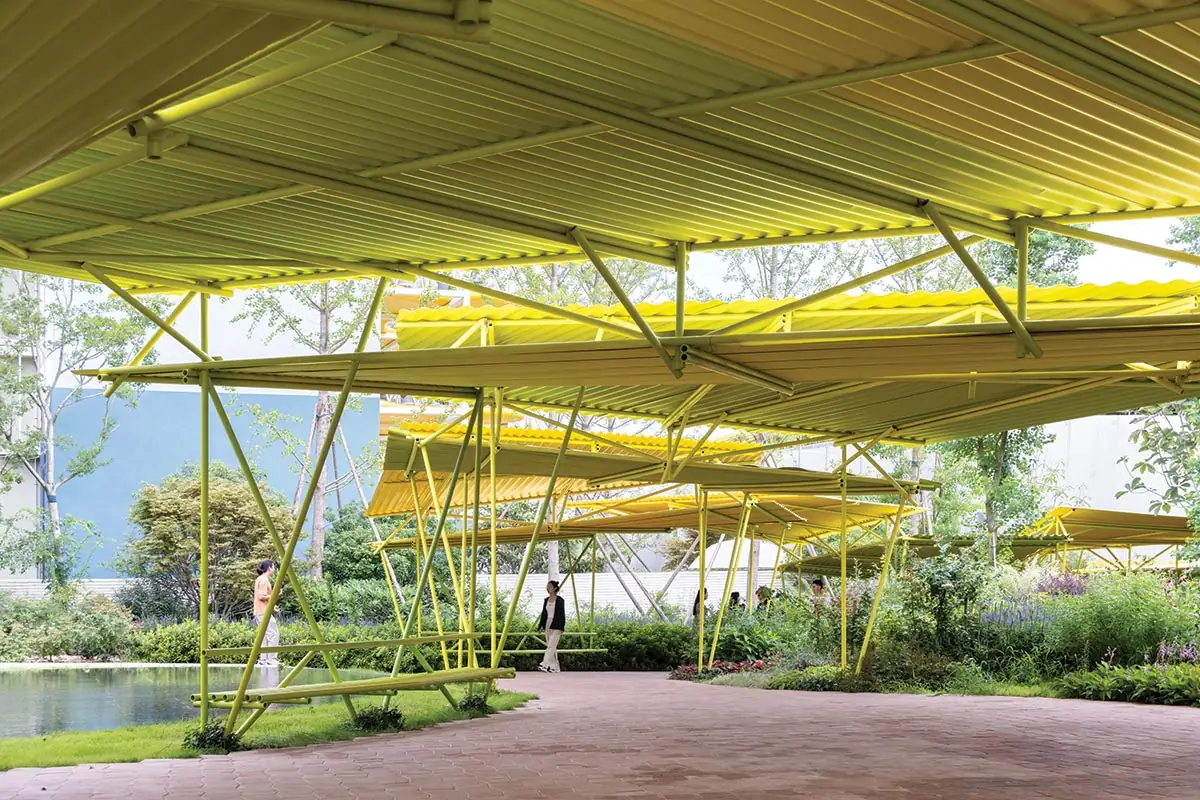
3
The canopied path, café (3 & 4), and multihued housing (5) are among new local projects that include Ishigami’s art museum. Photos © Iwan Baan
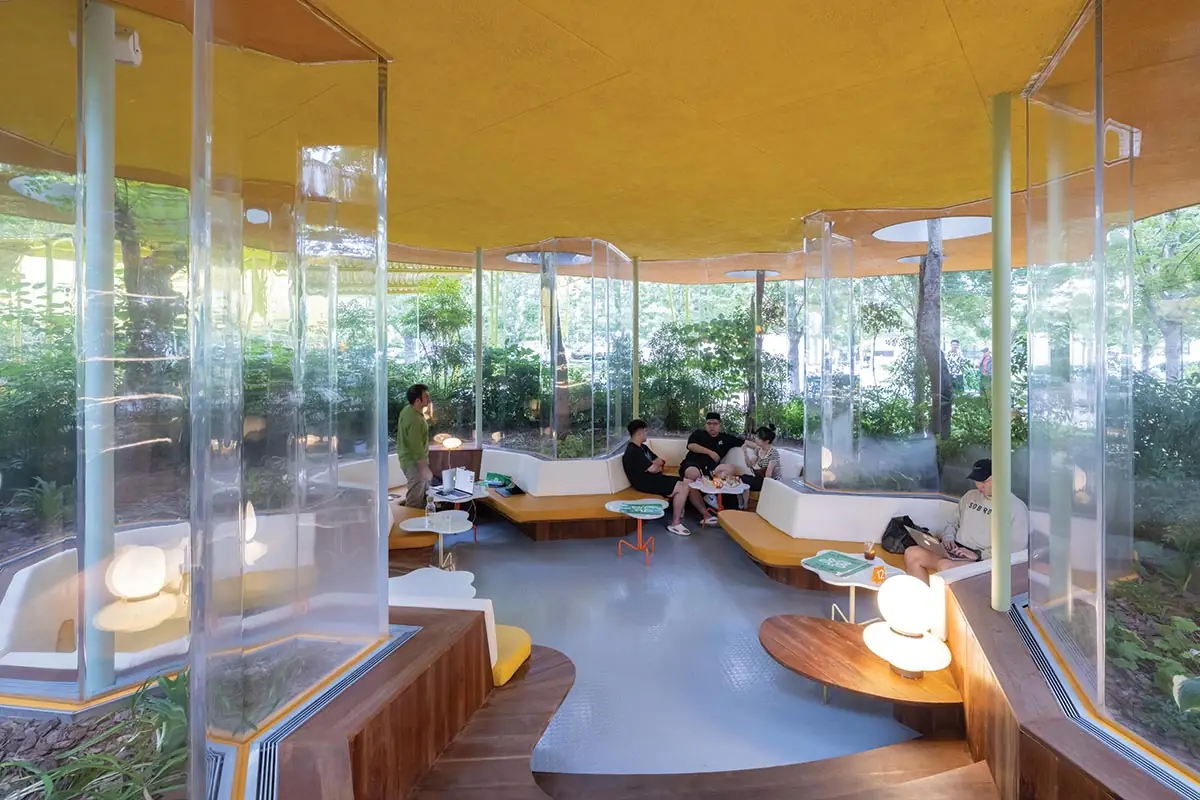
4
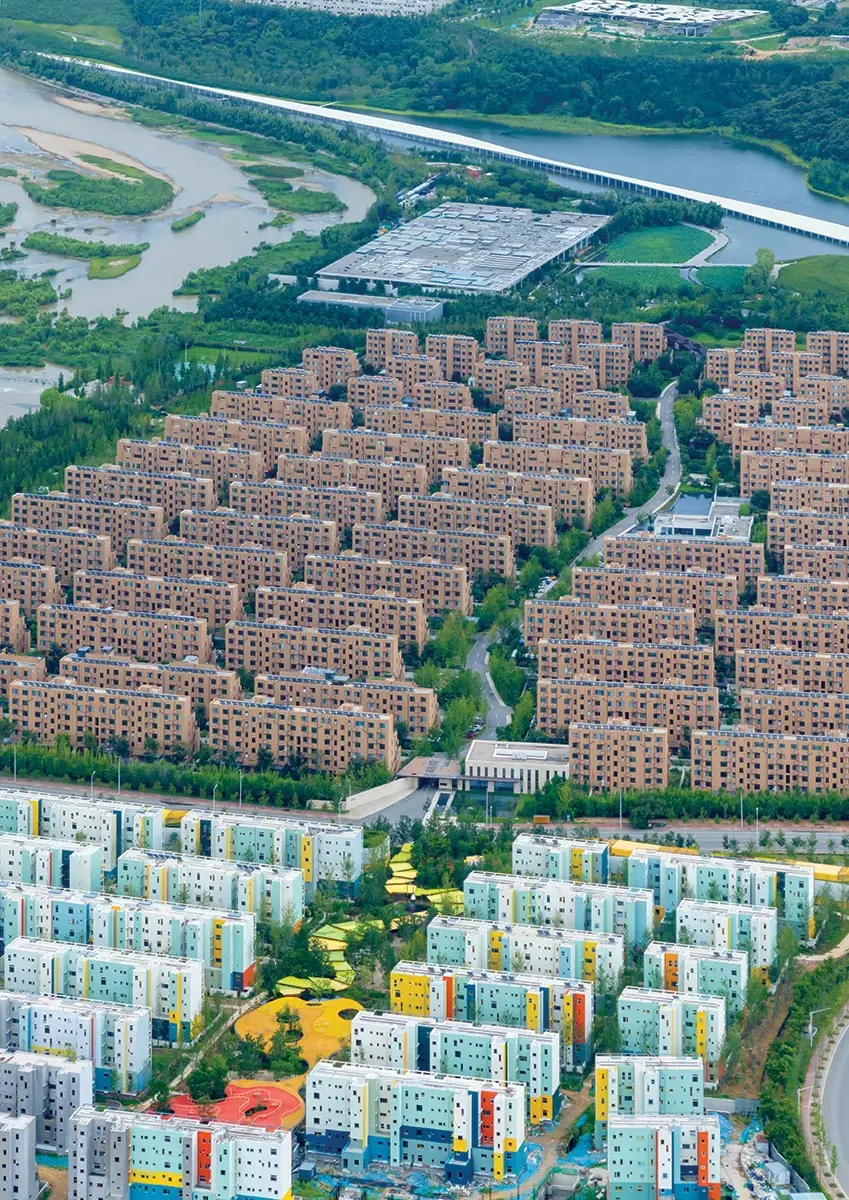
5
The north end of the walkway attaches to an amoeba-shaped canopy that from above looks like the bulbous lump in the gut of a snake that has just eaten its prey. At the head of the serpent, the architects designed the café with holes cut out of the roof for trees to grow through. The “coffee-and-tree café” is the only portion of the project with an enclosed space. It is wrapped on all sides with clear floor-to-ceiling acrylic panels, 2 inches thick and a little more than 8 feet high. SelgasCano often uses acrylic in projects, because it’s half the weight of glass, is recyclable, and requires much less energy to fabricate, being heated to 300 degrees Fahrenheit, rather than 3,000 for glass. The acrylic for the project was manufactured in China by a company that works on aquariums, and was delivered to the site in five large pieces that were quickly installed.
“The most important part of the project is the landscape,” says Selgas. Whether you’re on the walkway or in the café, you’re always surrounded by trees and plantings. “On most projects, landscaping is the last thing considered and the first to get cut. Not here.”
A curving steel stair with tubular railings leads to a rooftop sitting area above the café. For the top surface of the concrete-slab roof, Selgas and Cano specified a material made of recycled tires. For the ceiling in the café and the soffit of the cantilevered roof, they used a recycled-wood-and-resin material that has the feel of wood. The wide eaves and the trees all around the café protect the interiors from the full impact of the sun.
The architects also designed two wave-shaped bus shelters, clad on the inside with slender yellow and white tubes and on the outside with a reflective metal skin that helps them disappear within their setting. Along the access road, they designed colorful metal awnings for a long retail structure and six sinuous pavilions made of painted rebar that sit in a rooftop garden. And, just to the west of the walkway at its start, they created a curvaceous terrace with a small “capsule kitchen” and plenty of tables and chairs.
A high-energy jolt of architectural exuberance, the walkway and café projects entice residents to come and relax, to explore and play, to stroll and hang out. Bisecting the property, they serve as common ground for kids, parents, and seniors. They’re both a line and a hub. And they do all this by balancing the needs for both standing out and fitting in, especially with nature.
Click section to enlarge
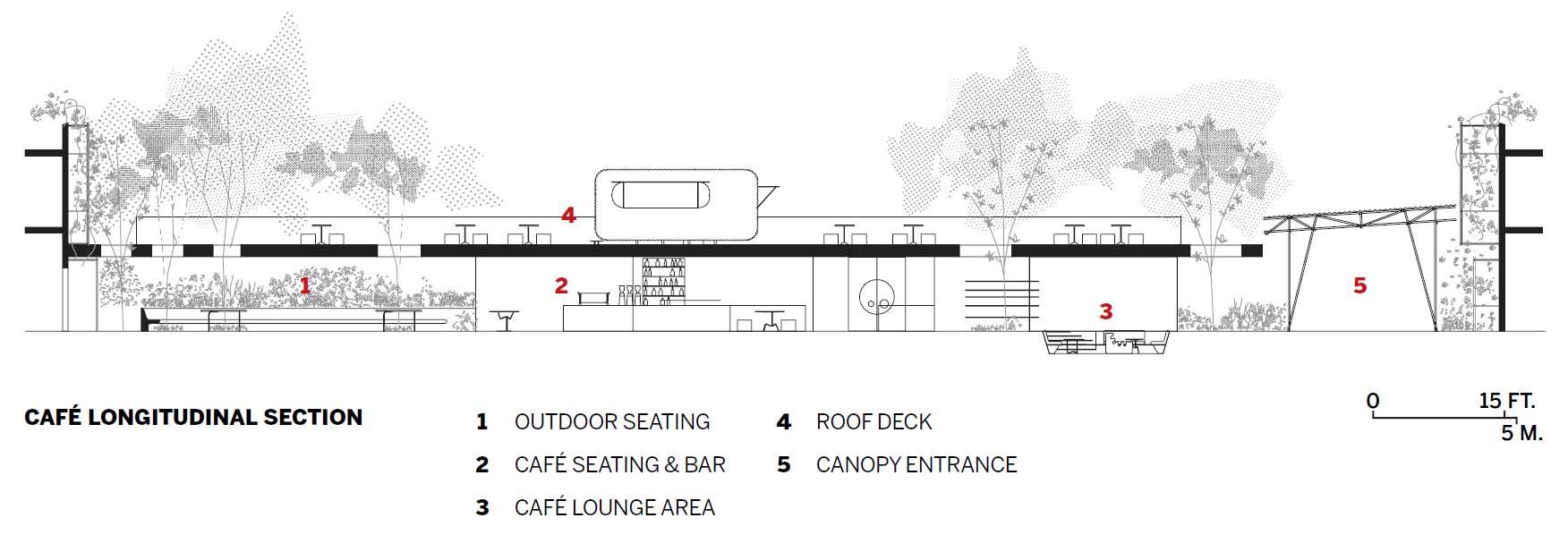
Credits
Architect:
SelgasCano — José Selgas, Lucía Cano, principals in charge; Paolo Tringali, Inés Olavarrieta, Justo Díaz, Juan Díaz, Alejandro Jiménez, Ying Zhu, project team
Engineers:
IDI Ingenieros
Consultant:
DVELAS (furniture)
Client:
Shandong Bailuwan Company
Size:
13,000 square feet (site)
Cost:
Withheld
Completion Date:
January 2023



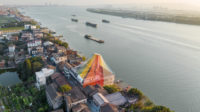
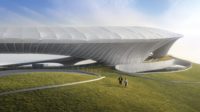
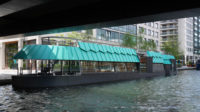
Post a comment to this article
Report Abusive Comment